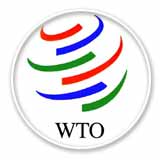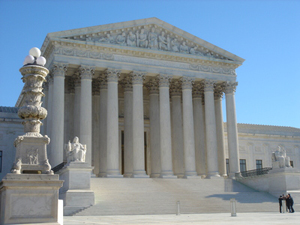 Fritz Machlup (at right), an economist, once said that if we didn't have a patent system it would be irresponsible to recommend one, but since we have one, it would be irresponsible to abolish it. An Economic Review of the Patent System (Subcomm. on Patents, Trademarks, and Copyrights of the S. Comm. on the Judiciary, Study No. 15, 85th Cong., 2d Sess. (Comm. Print 1958)). Today, we are in the interesting position of having many groups, from high tech companies and industry to non-governmental organizations, both foreign and domestic arguing for policies that would diminish if not abolish the patent system. This is ironic, because the U.S. over the past thirty years has made the patent system more transparent, uniform and in harmony with other nations' patent systems, and both the economy and society have benefited.
Fritz Machlup (at right), an economist, once said that if we didn't have a patent system it would be irresponsible to recommend one, but since we have one, it would be irresponsible to abolish it. An Economic Review of the Patent System (Subcomm. on Patents, Trademarks, and Copyrights of the S. Comm. on the Judiciary, Study No. 15, 85th Cong., 2d Sess. (Comm. Print 1958)). Today, we are in the interesting position of having many groups, from high tech companies and industry to non-governmental organizations, both foreign and domestic arguing for policies that would diminish if not abolish the patent system. This is ironic, because the U.S. over the past thirty years has made the patent system more transparent, uniform and in harmony with other nations' patent systems, and both the economy and society have benefited.
Which is not to say that the system is perfect -- far from it. As a human institution perfection is impossible. But the motivations of many challenging the patent system should also be open to critical review, if only to establish that the alternatives, and the presumptions upon which they are built are in fact legitimate and entitled to the deference they frequently demand.
These questions are important because we live in a deeply technological age. The amount of innovation, in biology, chemistry, telecommunications, computing, and many other fields is unprecedented. Innovation does not depend on patenting per se; particularly in the life sciences, people will innovate, and discover, and invent, regardless of what Lincoln called the "fuel of interest," because researchers (and, indeed, human beings generally) have a deep desire to understand how the world works, particularly our corner of it, and to alleviate disease when we can. Where patenting comes in has been in commercialization, getting products to market, and doing so in a way that they are safe, effective, and with a minimum of significant side effects.
 We have achieved these societal benefits and safeguards by increasing the regulatory environment from the days when Jonas Salk (at left) developed his polio vaccine. Salk famously did not patent his vaccine (not necessarily from altruism, there being serious doubts about whether prior art prevented patenting). But Salk also did not need to endure the extensive regulatory burden required today (and, according to the book Patenting the Sun availed himself of test populations that would not be permitted today). That is true in large part because Salk worked before the thalidomide disaster, which caused reform in how drugs were tested and increased their costs by requiring more extensive pre-market testing to ensure safety as well as efficacy. In addition, as Richard Epstein has written, most of the low hanging fruit of pharmaceutical research has been plucked and drug development has increased in cost. And these features of the current innovation landscape include not only the drugs themselves but the diseases they treat; we have moved from a past where simple bacterial infections were treated to developing drugs for the diseases of aging (cancer, diabetes, and Alzheimer's, and Parkinson's diseases) that are treated by drugs (biologic drugs) vastly more complex in structure and more difficult to produce. All this has led to increased costs that invoke an increased need for patent exclusivity to ensure sufficient return on investment to justify those costs.
We have achieved these societal benefits and safeguards by increasing the regulatory environment from the days when Jonas Salk (at left) developed his polio vaccine. Salk famously did not patent his vaccine (not necessarily from altruism, there being serious doubts about whether prior art prevented patenting). But Salk also did not need to endure the extensive regulatory burden required today (and, according to the book Patenting the Sun availed himself of test populations that would not be permitted today). That is true in large part because Salk worked before the thalidomide disaster, which caused reform in how drugs were tested and increased their costs by requiring more extensive pre-market testing to ensure safety as well as efficacy. In addition, as Richard Epstein has written, most of the low hanging fruit of pharmaceutical research has been plucked and drug development has increased in cost. And these features of the current innovation landscape include not only the drugs themselves but the diseases they treat; we have moved from a past where simple bacterial infections were treated to developing drugs for the diseases of aging (cancer, diabetes, and Alzheimer's, and Parkinson's diseases) that are treated by drugs (biologic drugs) vastly more complex in structure and more difficult to produce. All this has led to increased costs that invoke an increased need for patent exclusivity to ensure sufficient return on investment to justify those costs.
 In addition, our age is characterized by innovation being harnessed not just by companies but by universities, whereby scientific discoveries are protected by patents and licensed to industry under the auspices of the Bayh-Dole Act rather than being expropriated by companies, foreign, or domestic. This also increases costs and can result in reduced efficiency (economic and industrial), but also results in significant benefits to universities and the return on public investment. For example, Myriad Genetics has paid $57 million in royalties to the University of Utah and other research institutions for licensing the patents on the BRCA breast and ovarian cancer tests, and those monies in large part have been reinvested by the universities to fund further research and the capital investment (in laboratory facilities, instruments as well as manpower) needed for that research.
In addition, our age is characterized by innovation being harnessed not just by companies but by universities, whereby scientific discoveries are protected by patents and licensed to industry under the auspices of the Bayh-Dole Act rather than being expropriated by companies, foreign, or domestic. This also increases costs and can result in reduced efficiency (economic and industrial), but also results in significant benefits to universities and the return on public investment. For example, Myriad Genetics has paid $57 million in royalties to the University of Utah and other research institutions for licensing the patents on the BRCA breast and ovarian cancer tests, and those monies in large part have been reinvested by the universities to fund further research and the capital investment (in laboratory facilities, instruments as well as manpower) needed for that research.
Part of the backlash against patents comes from political disagreements over the role of universities in this process. Another part stems from high tech companies who view patents as tools that are used against them in litigation, either by smaller companies or companies that have licensed these patents from such small companies. These companies generally do not use patents the way life sciences companies do, to protect their investment, bur rather as negotiating tools for obtaining cross licenses from competitors. And some of that has to do with the differences in development costs and obsolescence timelines. A drug can cost $1 billion to bring to market but has a long time to obsolescence; indeed, drug and other life sciences patents are frequently most valuable in the last few years of their term (which is one reason Myriad continues to sue alleged infringers of their cancer testing patents). Computer and other high tech inventions have much shorter timelines (would you want to use a phone from 1995?) and lower development costs (perhaps as little as a bright 17 year old working on a computer in his garage). These differences have been translated into political differences between life sciences companies that need patents for investment, and high tech companies that fight "patent wars" over cell phone technology on the business pages of the Wall Street Journal. One size does not fit all.
 Another aspect of the patent challenge is internationally, particularly in developing countries. In the mid-1990's, a part of the GATT treaty termed TRIPS was ratified by most countries around the world, mostly for the benefit of joining the World Trade Organization with concomitant reductions in tariffs between countries. As part of these agreements, signatory countries had to agree to respect intellectual property rights, primarily as a way for pharmaceutical and biotech patenting to be available in countries like Brazil and India that had traditionally nor permitted such subject matter to be patented. Unfortunately, these agreements did not take into account the justifiable concerns of developing countries over the cost of patented drugs, and the agreements began to have reduced effectiveness almost immediately. First, while membership in the WTO was immediate, requirements to change an individual country's patent laws were delayed up to six years after signing. Next, the Doha declaration was enacted by the WTO, which permitted member countries to impose compulsory licenses or otherwise ignore pharmaceutical patent rights for medical emergencies and other reasons, which reasons have expanded to include almost anything since the declaration's enactment. This resulted in a trend in Brazil, India, South Africa, and other countries to impose such licenses, or to demand local "working" of patents, or otherwise reduce patent protection in these countries, until today the situation is pretty much the same as it was before TRIPS was enacted.
Another aspect of the patent challenge is internationally, particularly in developing countries. In the mid-1990's, a part of the GATT treaty termed TRIPS was ratified by most countries around the world, mostly for the benefit of joining the World Trade Organization with concomitant reductions in tariffs between countries. As part of these agreements, signatory countries had to agree to respect intellectual property rights, primarily as a way for pharmaceutical and biotech patenting to be available in countries like Brazil and India that had traditionally nor permitted such subject matter to be patented. Unfortunately, these agreements did not take into account the justifiable concerns of developing countries over the cost of patented drugs, and the agreements began to have reduced effectiveness almost immediately. First, while membership in the WTO was immediate, requirements to change an individual country's patent laws were delayed up to six years after signing. Next, the Doha declaration was enacted by the WTO, which permitted member countries to impose compulsory licenses or otherwise ignore pharmaceutical patent rights for medical emergencies and other reasons, which reasons have expanded to include almost anything since the declaration's enactment. This resulted in a trend in Brazil, India, South Africa, and other countries to impose such licenses, or to demand local "working" of patents, or otherwise reduce patent protection in these countries, until today the situation is pretty much the same as it was before TRIPS was enacted.
In the U.S., a rising chorus of members of the IT community, academics, NGOs, courts, and government officials concerned about the high cost of drugs and patent litigation has changed the zeitgeist, with the common perception being that the patent system is broken. The culprits are putatively the PTO and the Federal Circuit, where the PTO allegedly was granting too many "bad" patents and the Federal Circuit culpable for upholding them. This political climate resulted in a large-scale reduction in patents in the middle part of the past decade and increased Supreme Court review of Federal Circuit decisions. While the rate of patent grant has returned to its historical averages lately (about 60%) the refusal to grant patents created a balloon of pending applications, and the sequester and other budgetary limitations have blunted the Office's ability to address the backlog effectively.
 There has also been a large amount of skepticism by the Supreme Court about both the Office and the Federal Circuit. Justice Kagan has termed the PTO "patent happy" and Justice Scalia has called the concept of obviousness "gobbledegook." Supreme Court review of Federal Circuit decisions has clarified the law in many respects, but recent decisions regarding diagnostic method patents and patents on natural products have the potential to reduce patenting in the life sciences for largely philosophical reasons not aligned with the practical realities of commercialization.
There has also been a large amount of skepticism by the Supreme Court about both the Office and the Federal Circuit. Justice Kagan has termed the PTO "patent happy" and Justice Scalia has called the concept of obviousness "gobbledegook." Supreme Court review of Federal Circuit decisions has clarified the law in many respects, but recent decisions regarding diagnostic method patents and patents on natural products have the potential to reduce patenting in the life sciences for largely philosophical reasons not aligned with the practical realities of commercialization.
Concerns about cost and access motivate much of the debate. But it is important to recognize that some of this debate stems from a classic contest between producers and consumers of technology: consumers (physicians and patients, and increasingly payors like insurance companies and governments) always want technology quicker, cheaper, easier, and this can be and frequently is contrary to the reality of providing drugs and diagnostics that are efficacious and reliable.
The fact is that technology has three ways to be commercialized: supported by patenting, wherein investors produce new industries as the result in "creative destruction" of old paradigms. Or by corporate expropriation, where inventions are taken by large corporations and then brought to market under circumstances where creative destruction is prevented or retarded by established products. Or by trade secret protection, where efforts are made to increase the difficulty in reverse engineering a product and the inability to patent results in non-disclosure of the invention (with concomitant reduction in the public's body of knowledge).
We also need to be cognizant of myths that arise around efforts to disparage patents. Myriad again provides a good illustration. For example, the ACLU and their friends promulgated the myth that patents impede basic research. This is a myth started by speculation in an article by Rebecca Eisenberg and Mike Heller published in 1998 in Science and entitled "Can Patents Deter Innovation? The Anticommons in Biomedical Research" containing the concept that there could be a "tragedy of the anti-commons." As it has turned out, no tragedy has ariseng -- the overwhelming weight of the evidence is that patenting does not affect basic genetic research. In the case of the BRCA genes, for example, there have been more than 10,000 scientific journal articles published since the BRCA gene patents were granted. There is simply no empirical evidence of tragedy, from the BRCA gene patents or any others.
Another myth is that gene patents mean someone "owns" you. First, the 13th Amendment prevents a property ownership right in a human being, so that possibility is eliminated. But moreover, claims to genes are specific to sequence, and the chance that any individual's genes are identical to any other is very small, due to natural, neutral variation in the population. Gene patents don't impede anyone's right to their own genetic information, because the information isn't patented. Methods for determining that information may be, but the information itself is not.
There needs to be a recognition once again of some fundamental truths behind innovation and the role of the patent system in increasing innovation. First, patents are limited in term -- like a bottle of milk they have an expiration date and when they expire the invention is freely available to anyone. Second, patents require disclosure, in many cases greater disclosure than a scientific paper. Two examples illustrate this point. In the Nature paper disclosing the analytical technique of sodium dodecyl sulfate-polyacrylamide gel electrophoresis (SDS-PAGE), which illustrated the process by separating the dozen or so proteins that made up a bacterial virus, and in the legend of the figure showing this separation was the footnote that said that details of the SDS-PAGE technique were in a manuscript in preparation to be published later. Such a paper was never published; while there were later book chapters and other detailed descriptions of the technique they were by others who had adopted the technique, and in addition to being secondary from the scientist who "invented" it, these references were much later in time after the publication announcing the technique. In contrast, a patent on that method would have required a written description of how to practice the invention in such "full, clear, concise, and exact" terms that could be understood by the person skilled in the relevant art, as well as describing the usefulness of the technique.
As another example, when the results of the Human Genome Project were published, many in the scientific community were content with publication of a sequence and a description of how similar in sequence the "new" gene was to other known genes. That was not good enough to get a patent, however. The PTO required that an applicant disclose at least one specific, substantial, and credible utility for the protein encoded by the new gene, which resulted in immediate, practical disclosure. This meant that when those patents expired the public would be in possession not only of the gene but would know what the gene was useful for, and arguably accelerated the speed with which the fruits of the HGP were appreciated.
Third, the consequence of reducing the effectiveness of patents will be that innovation will not suffer but commercialization will. Myriad once again provides an example. Myriad has stated in court papers that it spent about $500 million to bring its BRCA tests to market, after it had identified the genes. These monies were needed to establish a laboratory with the proper controls that minimized false results, something no one has ever accused Myriad of producing. (For those who point to the absence of "second opinion" testing, there is no reason to think that false positives are more frequent than false negatives, which means an error-prone test would produce results indicating the absence of a BRCA mutation in women having it, and these women should have developed BRCA-specific breast or ovarian cancer. There are no reports that this has happened, suggesting that Myriad established sufficiently robust procedures, which we can expect were part of its investment costs.) Myriad also incurred the costs of informing ob/gyn physicians of the test and convincing them it was useful, at a time when genetic diagnostic testing was still considered experimental and where the type of genetic determinants for cancer like BRCA were considered extremely rare. In addition, Myriad needed to set up a network of genetic counselors, since the diagnosis that a woman carried a BRCA mutation, in a family context of breast cancer in mothers, grandmothers, aunts, etc. was understandably terrifying. Myriad also needed to convince public and private payors that its tests were reliable and effective and, most importantly, could justify the cost of the test by the savings resulting from reduction in breast cancer frequency.
Myriad did none of this solely from altruism, of course. But Iit is unlikely that the number of women receiving the test would have been significantly higher if the Utah researchers had made the test freely available, if only for reasons of demographics. If provided by university hospitals, for example, women in New York, or Chicago, or Boston, or San Francisco certainly would have been able to get the test. But it is much less likely that women in rural Appalachia, or the Four Corners region of the southwest, or in Idaho would have had access to the test. These are economic realities that have had no place in the public debate over gene patenting.
There is also a risk in giving courts the power to subjectively decide the proper "balance" between too much and too little patents, particularly on categorical grounds like subject matter eligibility. Courts are particularly unlikely to have the scientific understanding to apply the law to new technologies; that's the Patent Office's job, and the law gives the agency a broad scope ("anything under the sun made by man"). There is no way a priori to decide what "too much" patenting is, and the question is fraught with the politics of competition: of course a company might think that its competitor's patents are "bad" because they block the company from commercializing a product (disregarding the potential for licensing that the patent system intends to promote). The Supreme Court has recently given the impression that they have a Goldilocks role in deciding the proper balance of patent eligibility. This thinking is illustrated by the fact that, until now, there was not Supreme Court precedent supporting a "product of nature" ban on patent eligibility. One of the consequences of the Myriad decision is that it has put into question the patent eligibility of claims to natural products that are isolated and otherwise unchanged. The logical fallacy of this decision can be appreciated by this hypothetical: if a scientist discovered a protein produced in a human that regulated blood pressure, the closer the drug developed by the scientist was to the natural protein (and hence the more like the native molecule the drug was, in turn being closest to the protein's natural properties of half-life, potency, etc.) the less patent eligible the molecule would be. That can't be right.
Think about the following inventions and whether they should be patent eligible (and why):
• Isolated chemical compound from crude oil useful as a lubricant
• Isolated antibiotic produced by bacteria
• Isolated chemical compound from a plant useful as a drug
• Isolated protein from an animal useful to cure/ameliorate human disease
• Isolated cucumber gene that extends freshness
• Isolated Human gene (erythropoietin)
Deciding that some or none of these inventions deserve patent protection has consequences, and there is a need to balance any philosophical bases for excluding any of them from patent eligibility with the practical effects of doing so.
We live in a technological age, and part of the success of that age stems from the capacity of patent exclusivity to encourage investment and bring products to market. For the past thirty years this has created a society of economic growth and the capability to better diagnose and treat disease unknown in the past. Patents are not the only reason but they have played their part. In our efforts to address patenting's shortcomings, it is important that we do not overly diminish their proper role.